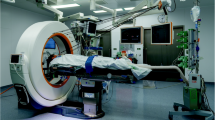Summary
There is discrepancy between the exact representation of anatomical structures and tumours in the CT or MRI scan and the more or less accurate intra-operative localisation methods based mostly upon landmarks of the skull and extracerebral space and visible abnormalities of the cerebral surface.
To overcome these problems of exact intra-operative localisation a Computer Assisted Localizer (CAL) is presented which allows precise intra-operative orientation without these aids.
It consists of a mechanically articulated arm with six degrees of freedom with a high precision digital incremental and an image processor for 3 D data of the head. MRI and/or CT investigation is done pre-operatively with four reference markers fixed on the patient's head. They are visible on the CT or MRI slices and are used as reference points during surgery for adjustment of the device.
The co-ordinates of the digitalizer arm tip are projected into the corresponding axial, sagittal and coronal CT slices so that the system simultaneously presents three orthogonal multiplanar CT reconstructions with a reticule indicating the position of the tip of the arm. As the surgeon directs the arm to the region of interest the corresponding CT slices are displayed on the monitor at a rate of 20 slices/sec determined by the motion of the arm. The accuracy of measurement of the device itself lies within 1 mm.
The accuracy is somewhat reduced however by the thickness of CT or MRI slices (routinely 2 mm slices were taken) and by deviations of the reference markers on the skin surface which amount up to 3 mm.
Intra-operatively the accuracy decreases with CSF and tumour removal. Nevertheless the system has proved to be extremely useful in 50 cases to focus a trepanation and to guide the surgeon to subcortical lesions, invisible from the surface of the brain.
Similar content being viewed by others
References
Adams L, Krybus W, Meyer-Ebrecht D, Ruegger R, Gilsbach J, Moesges R, Schloendorff G (1990) Computer assisted surgery. Comp Graph Appl 10: 43–51
Doll J, Schlegel W, Pastyr O, Sturm V, Maier-Borst W (1987) The use of an industrial robot as a stereotactic guidance system. In: Lemke HU, Rhodes ML, Jaffee CC, Felix R (eds) Proc International Symposium CAR 87. Springer, Berlin Heidelberg New York Tokyo, pp 374–378
Drake JM, Koy M, Goldenberg A, Kreindler D (1991) Computer- and robot-assisted resection of thalamic astrocytomas in children. Neurosurgery 29: 27–33
Guthrie BL, Kaplan R, Kelly PJ (1989) Freehand stereotaxy: neurosurgical stereotactic operating arm. Proc Neurosurgical Society America 59–61 (Abstr.)
Kato A, Yoshimine T, Hayakawa T, Tomita Yet al (1991) A frameless, armless navigational system for computer-assisted surgery. J Neurosurg 74: 845–849
Kosugi Y, Watanabe E, Goto Jet al (1988) An articulated neurosurgical navigation system using MRI and CT images. Proceeding IEEE 35 2: 147–151
Krybus W (1991) CAS: intra-operative Positionsmessung in der Chirurgie. Diss. RWTH Aachen pp 41–76
Lavallee S, Cinquin P, Demongeot J, Benabid AL, Marque I, Djaid M (1989) Computer assisted driving of a needle into the brain. In: Lemke HU, Rhodes ML, Jaffee CC, Felix R (eds) Proc International Symposium CAR 89. Springer Berlin Heidelberg New York Tokyo, pp 416–420
Moesges R, Schloendorff G (1988) A new imaging method for intra-operative therapy control in skull-base surgery. Neurosurg Rev 11: 245–247
Moesges R, Schloendorff G, Klimek L, Meyer-Ebrecht D, Krybus W, Adams L (1987) CAS- Computer assisted surgery. An innovative surgical technique in clinical routine. In: Lemke HU, Rhodes ML, Jaffe CC, Felix R (eds) Proc International Symposium CAR 87. Springer, Berlin Heidelberg New York Tokyo, pp 413–415
Reinhardt H, Meyer H, Amrein E (1988) A computer assisted device for the intra-operative CT-controlled localization of brain tumours. Eur Surg Res 20: 51–58
Roberts DW, Strohbehn JW, Hatch JF, Murray W, Kettenberger H (1986) A frameless stereotactic integration of computerized tomographic imaging and the operation microscope. J Neurosurg 65: 545–549
Watanabe E, Watanabe T, Manaka S, Mayanagi Y, Takakura K (1987) Three-dimensional digitizer (Neuronavigator): new equipment for computer tomography-guided stereotaxic surgery. Surg Neurol 27: 543–547
Watanabe E, Mayanagi Y, Kosugi Y, Manaka S, Takakura K (1991) Open surgery assisted by the neuronavigator, a stereotactic, articulated, sensitive arm. Neurosurgery 28: 792–799
Author information
Authors and Affiliations
Rights and permissions
About this article
Cite this article
Laborde, G., Gilsbach, J., Harders, A. et al. Computer assisted localizer for planning of surgery and intra-operative orientation. Acta neurochir 119, 166–170 (1992). https://doi.org/10.1007/BF01541803
Issue Date:
DOI: https://doi.org/10.1007/BF01541803



